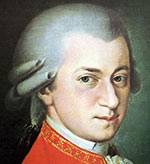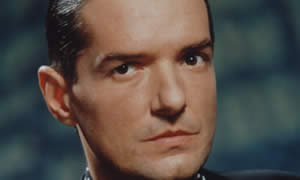Austrian Artists
Johann Strauss
 Johann
Strauss, often referred to as Johann Strauss II, was born on October
25, 1825, in Vienna, Austria. His father, Johann Strauss the Elder, was a
self-taught musician who established a musical dynasty in Vienna,
writing waltzes, galops, polkas and quadrilles and publishing more than
250 works. Johann the Younger went on to write more than 500 musical
musical compositions, 150 of which were waltzes, and he surpassed both
his father's productivity and popularity. Compositions such as The Blue Danube helped establish Strauss as "the Waltz King" and earned hi
Johann
Strauss, often referred to as Johann Strauss II, was born on October
25, 1825, in Vienna, Austria. His father, Johann Strauss the Elder, was a
self-taught musician who established a musical dynasty in Vienna,
writing waltzes, galops, polkas and quadrilles and publishing more than
250 works. Johann the Younger went on to write more than 500 musical
musical compositions, 150 of which were waltzes, and he surpassed both
his father's productivity and popularity. Compositions such as The Blue Danube helped establish Strauss as "the Waltz King" and earned hi
m a place in music history. He died in Vienna in June 1899.
Strauss
began composing for the Vienna Men's Choral Association in 1847. His
father died two years later, prompting him to conflate his own and his
father's orchestras, after which he mounted a successful career. In
1853, Strauss fell ill, and his younger brother, Josef, took control of
the orchestra for six months. After recovering, he dove back into
conducting and composing activities—a pursuit that proved to be stronger
than ever, gaining the eventual attention of such luminaries as Verdi, Brahms and Wagner.
An der schönen blauen Donau (The Blue Danube;
1867) would be the piece that defined Strauss to the listening public,
and the work still resonates 150 years later. Other Strauss waltzes
include Morgenblätter (Morning Papers; 1864), Geschichten aus dem Wienerwald (Tales from the Vienna Woods; 1868) and Wein, Weib und Gesang (Wine, Women and Song; 1869).
Wolfgang Amadeus Mozart
 Mozart was born in Salzburg to a musical family. From an early age,
the young Mozart showed all the signs of a prodigious musical talent. By
the age of 5 he could read and write music, and he would entertain
people with his talents on the keyboard. By the age of 6 he was writing
his first compositions. Mozart was generally considered to be a rare
musical genius, though Mozart said that he was diligent in studying
other great composers such as Haydn and Bach.
Mozart was born in Salzburg to a musical family. From an early age,
the young Mozart showed all the signs of a prodigious musical talent. By
the age of 5 he could read and write music, and he would entertain
people with his talents on the keyboard. By the age of 6 he was writing
his first compositions. Mozart was generally considered to be a rare
musical genius, though Mozart said that he was diligent in studying
other great composers such as Haydn and Bach.
During his childhood, he would frequently tour various palaces around
Europe playing for distinguished guests. Aged 17, he accepted a post as
a court musician in Salzburg; although this did not suit him very well,
the next few years were a time of prolific composition. In 1781, he
moved permanently to Vienna where he stayed for remainder of his life.
In Vienna, he became well known and was often in demand as a composer
and performer.
However, despite his relative fame and renown he struggled to manage
his finances and moved between periods of poverty and prosperity. This
difficulty was enhanced when, in 1786, Austria was involved in a war
which led to lower demand for musicians. In 1782, he married against the
wishes of his family; he had 6 children but only 2 survived infancy.
The work of Mozart is epic in scope and proportion. There were few
branches of music Mozart did not touch. He composed operas, symphonies,
concertos, and single pieces for the piano. His work spanned from joyful
lighthearted pieces to powerful, challenging compositions which touched
the human emotions. In the beginning of his career, Mozart had a
powerful ability to learn and remember from the music he heard from
others. He was able to incorporate the style and music of people such as
Haydn and J.C. Bach. But, as he matured he developed his very own style
and interpretations. In turn the music of Mozart very much influenced
the early Beethoven
Mozart was brought up a Roman Catholic and remained a member of the church throughout his life.
Some of his greatest works are religious in nature such as ‘Ave Verum Corpus’ and the final Requiem. Mozart was very productive until his untimely death in 1791, aged 35.
In the last year of his life, he composed the opera The Magic Flute,
the final piano concerto (K. 595 in B-flat), the Clarinet Concerto K.
622, a string quintets (K. 614 in E-flat), the famous motet Ave verum corpus K. 618, and the unfinished final Requiem K. 626.
Falco
Falco was the most internationally successful pop artist ever to come
out of Austria, best known for his 1986 chart-topping hit "Rock Me
Amadeus." Born Johann Holzel in Vienna on February 19, 1957, he was a
classically trained child prodigy, but after graduating from the Vienna
Conservatoire, he relocated to West Berlin and began fronting a
jazz-rock band. Rechristening himself Falco in honor of the German skier
Falko Weissflog, he returned to Vienna in time to play bass on the punk
outfit Drahdiwaberl's 1979 album Psycho Today, penning their best-known
song, "Ganz Wein." Falco began his solo career in 1982 with the LP
Einzelhaft; his "Der Kommissar," which fused techno-pop with rapped
German lyrics, became a major European hit and a club favorite in the
U.S., with a cover version by the group After the Fire reaching the Top
Five in 1983. The follow-up, "Jeanny," was banned outright by radio as a
result of its theme of prostitution, but nevertheless went on to top
the German charts. While 1984's Junge Roemer attracted little attention,
in 1986 Falco issued Falco 3, highlighted by the single "Rock Me
Amadeus," a campy blend of classical music and synth pop which topped
both the American and British charts. While the rock ballad "Vienna
Calling" was a minor hit, Falco's subsequent efforts, including 1986's
Emotional and 1988's Wiener Blut, fared poorly; he had been long out of
the spotlight when he died in a car accident on February 6, 1998 at the
age of 40.
Gustav Klimt (1862-1918) was one of the most innovative and
controversial artists of the early twentieth century. The son of an
engraver, he studied at the State School of Applied Arts in Vienna. In
the 1880s and 1890s he produced murals for public buildings -- including
Vienna's Burgtheater and new Kunsthistorisches Museum (Art History
Museum) -- in the prevailing classical-realist style. Klimt's style grew
increasingly experimental, however, and his murals for Vienna
University, commissioned by the State in 1894, were roundly attacked by
critics for their fantastical imagery and their bold, decorative style.
Partly in response to this reaction, in 1897 Klimt helped form the
Secession, a group of artists dedicated to challenging the conservative
Academy of Fine Arts. Influenced by European avant-garde movements
represented in the annual Secession exhibitions, Klimt's mature style
combined richly decorative surface patterning with complex symbolism and
allegory, often with overtly erotic content.
After 1900 he concentrated on portraits and landscapes, although he also produced two of his greatest murals during this period -- The Beethoven Frieze, exhibited at the Secession in 1902, and decorations for the Palais Stoclet in Brussels (1904-1911). Klimt spent most of his summers on the Attersee, near Salzburg, where he drew inspiration for many of his landscapes, and where he painted some of his best-known works, including The Kiss of 1907-8
Gustav Klimt
 |
After 1900 he concentrated on portraits and landscapes, although he also produced two of his greatest murals during this period -- The Beethoven Frieze, exhibited at the Secession in 1902, and decorations for the Palais Stoclet in Brussels (1904-1911). Klimt spent most of his summers on the Attersee, near Salzburg, where he drew inspiration for many of his landscapes, and where he painted some of his best-known works, including The Kiss of 1907-8


No comments:
Post a Comment